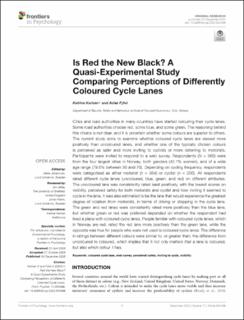| dc.description.abstract | Cities and road authorities in many countries have started colouring their cycle lanes. Some road authorities choose red, some blue, and some green. The reasoning behind this choice is not clear, and it is uncertain whether some colours are superior to others. The current study aims to examine whether coloured cycle lanes are viewed more positively than uncoloured lanes, and whether one of the typically chosen colours is perceived as safer and more inviting to cyclists or more deterring to motorists. Participants were invited to respond to a web survey. Respondents (N = 560) were from the four largest cities in Norway, both genders (42.1% women), and of a wide age range (79.6% between 30 and 70). Depending on cycling frequency, respondents were categorised as either motorist (n = 354) or cyclist (n = 206). All respondents rated different cycle lanes (uncoloured, blue, green, and red) on different attributes. The uncoloured lane was consistently rated least positively, with the lowest scores on visibility, perceived safety for both motorists and cyclist and how inviting it seemed to cycle in the lane. It was also estimated to be the lane that would experience the greatest degree of violation from motorists, in terms of driving or stopping in the cycle lane. The green and red lanes were consistently rated more positively than the blue lane, but whether green or red was preferred depended on whether the respondent had lived a place with coloured cycle lanes. People familiar with coloured cycle lanes, which in Norway are red, rated the red lane more positively than the green lane, while the opposite was true for people who were not used to coloured cycle lanes. The difference in ratings between different colours were similar to, or greater than, the difference from uncoloured to coloured, which implies that it not only matters that a lane is coloured, but also which colour it has. | en_US |

